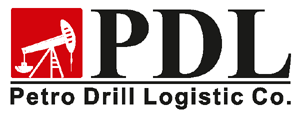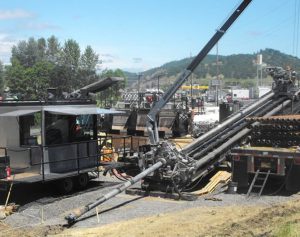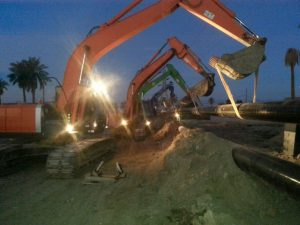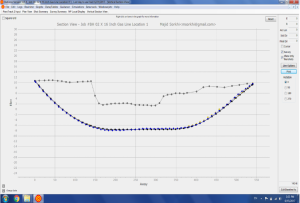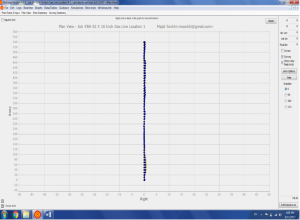PDL provide trenchless solutions for successful pipeline and utility installation projects, large or small. In environmentally sensitive areas, or in the heart of a city, we challenge conventional methods and generate results. We also believe that greater quality and higher technical standards shouldn’t come at a steep price. We push the boundaries of Horizontal Directional Drilling to innovatively maintain a competitive price point.
HDD Steps
STEP 1 – PILOT HOLE
The pilot hole is the beginning of the Directional Drill crossing. The Pilot hole is achieved either by excavation by jetting or by a down hole motor. Depending on the condition of the soil the pilot is drilled along a pre-determined alignment in which the path is selected by traditional methods.
The typical pilot hole on largest rigs is 9 7/8 but can vary depending on the soil conditions and rig size. Drilling fluid is pumped through the drill pipe to the drill head at which time it is jetted through or pumped through a drill motor. The end of the Drill Pipe is to core the pilot hole. The drill fluid lubricates the drill stem and carries out the cutting to the surface.
The drill fluid is then recycled and re-injected into the drill stem. The pilot process can take several days, depending on the condition of the soil and may require changing of the drill stem or drill head.
 STEP 2 – REAMING PROCESS
STEP 2 – REAMING PROCESS
Once the pilot hole has been completed the 2nd step takes place with a reamer, or hole opener. The hole openers come in different shapes and sizes and vary depending on the soil conditions and density of the soil; typically, a fly cutter is used in good ground conditions.
The reaming pass is done in several steps depending on the size of the hole, (example: 42″ finish hole would be 3 to 5 different ream passes 14″, 20″, 34″, 42″). The reamer is attached to the drill string and is rotated and pushed or pulled while rotating and drill fluid is pumped to the reamer through the drill pipe. The excavated soil is suspended in the drill fluid and then brought to the surface and recycled.
When the reamer is attached to the Drill string there will always be a drill pipe on both sides of the reamer allowing for the drill string to be in the hole at all times. The reaming process can take a significant amount of time depending on the condition of the soil.

STEP 3 – MUD PASS
After the desired hole has been achieved and the reamer has passed through it completely, a mud pass or packer reamer will be done to assure that the hole is clean of all excavated material and that the drill fluid has filled the hole completely, to allow for a smooth lubricated pull back of the pipe, avoiding friction of the pull section.

STEP 4 – PULLBACK PROCESS
The final step now is when the pipe is pulled into the reamed hole. A weld cap is installed on the pipe where a swivel is placed attaching the drill string, thus not allowing any rotation of the pipeline. Depending on the size of the pipe an artificial buoyancy measure might be taken. This is to keep the pipeline as close to neutral buoyancy. If no measures are taken several problems may occur (example: coating damage from pipe floating in drill fluid and causing excess friction causing more pull). Most typically buoyancy control is done with pumping water into the pipeline through P.V.C. pipe and checking the gallons pumped.
At completion of directional drill, demobilization and clean-up takes place.
We will be happy to provide you a drilling quote / proposal on any HDD project. Feel free to contact our sales team at any time.

